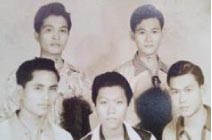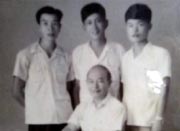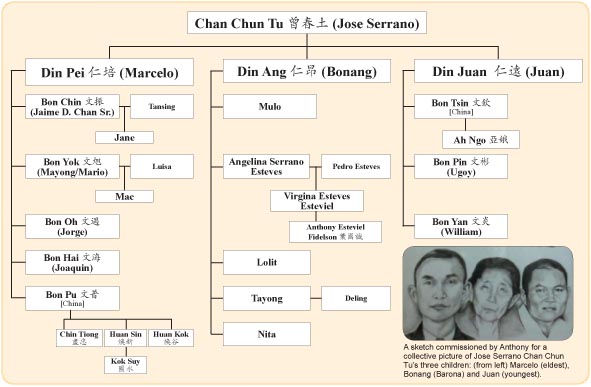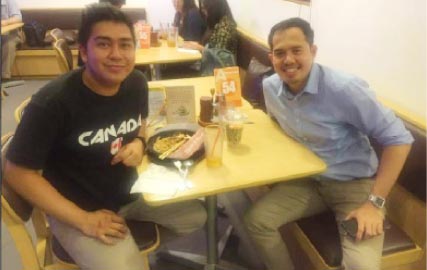This is about the journey of one of my roots-finding clients. His background mirrors mine: our mothers are both from the Chan (曾) lineage in Fujian. Like me, he too was at first oblivious of his Chinese roots, did not go to a Chinese school and learned the Hokkien language through Saturday classes and self-study. He became proficient enough to survive while visiting rural China with his mother.
While valuable information can be gleaned from old letters and photographs, his quest was achieved via an indirect route, which I coined as “search by association.” His story is a classic example of the power of the three P’s – patience, persistence and perseverance.

I am Anthony
My name is Anthony Esteviel Fidelson from the small town of Gubat, Sorsogon. I am a seaman working as a 2nd Cook in the international K-Line shipping vessel. After years of inquiries and research, connecting the dots from bits of information provided by elderly relatives, the search for my missing Chinese relatives came to fruition in 2018 when I finally met them in person.
Fourteen years ago, my classmates and I were discussing about the Chinese settlers in our town as part of our History project. I noted a prevalence of ethnic Chinese not only in Gubat but the entire Sorsogon. My classmate’s grandfather overheard us and remarked that my mother has Chinese blood because my maternal great-grandmother, Bonang (Barona Serrano Chan), was pure Chinese. I was taken aback by this information and immediately went home to verify.
A story from Mom
My mom (Virginia Esteves Esteviel) grew up in a very Filipino environment and never thought to mention our Chinese roots. She recounted how my maternal grandmother Angelina Serrano Esteves’ middle name of Chan was changed to Serrano when Angelina’s grandfather Chan Chun Tu (曾春土), married a Filipina and adopted the name Jose Serrano.
Mom was 10 years old when grandmother brought her to Legazpi to visit our Chan relatives. Lola Bonang, after marrying my great-grandfather Pedro Esteves, had moved to Gubat from Legazpi. Lola Bonang’s nephews, Bon Chin (Jaime D. Chan Sr. 曾文振), Bon Oh (Jorge Bayona Chan 曾文遇), Mayong (Mario Bayona Chan/Bon Yok 曾文旭) and Bon Hai (Joaquin Bayona Chan 曾文海), would often visit her in Gubat. They were generous and always gave coins to my mom and the other children.
I stayed with a relative in Legazpi while in college. The house belongs to my maternal granduncle Lolo Tayong. His wife, Lola Deling, would often recount stories about our Chan family. Tayong, Mulo and Lolit are siblings of my maternal grandmother Angelina, and grew up with the Chan family of Legazpi. They would help tend the family-owned store, OK Grocery, together with Bon Chin and other cousins. Unfortunately, after my great-grandmother Bonang died, all contacts with our Chan relatives died with her as well.

The local search
I learned from my mom that my deceased father and paternal grandmother were also of Chinese descent. This ignited my dream of tracing my Chinese roots even more.
Tracing my relatives would have been very difficult if not for Internet and Facebook. I searched through hundreds of FB profiles with the surname Chan. After several attempts, I finally found a certain Mac Chan and his picture of a tombstone with a caption that reads “Tata Bonchin and Nana Tansing.”
Although Chinese characters were engraved on it, there was an English name of Jaime Chan on the tombstone. Lola Bonang’s daughter Lola Nita confirmed that Tata Bonchin is Jaime Chan and Nana Tansing is Constancia Chan. (Lola Nita passed away on Jan. 6.) I quickly sent an FB message to Mac and got a reply several days later. After 40 years, the first contact with the Chan family was made.
Rekindling old family connections
In May 2015, along with relatives, we visited Uncle Mac’s family in Quezon City. He introduced us to his father Lolo Mayong (Bon Chin’s brother), mom Lola Luisa, and his siblings.
Lolo Mayong was critically ill, and was too weak to talk. I asked if he still remembers his aunt, my Lola Bonang, and he nodded. The two families did some catching up and even did a video call with their relatives in the United States.
In May 2016, I received news that Lolo Mayong has passed away. During the wake, I met Lolo Bon Oh and more Chan relatives. A week after the interment, Mac accompanied me to the Chan Mausoleum at the Eternal Garden to light incense and offer prayers to our ancestors. I had mixed emotions. I was happy to finally witness the tombstones of Lolo Bon Chin and Lola Tansing, and silently thanked him for always visiting my great-grandmother in Gubat. But sad as well seeing Lolo Mayong’s tombstone, whom I only met once.
The Chan ancestors’ remains in Legazpi were later moved to the Chan Mausoleum in Metro Manila. One tomb caught my attention: Jose Serrano Chan, my maternal great-great grandfather – the pioneer migrant to the Philippines.

Writing the family tree
So, with the active participation of relatives from Quezon City and Sorsogon, I was able to draw a huge portion of our family tree.
My maternal great-great-grandfather, Jaime Serrano Chan, was the first to migrate to the Philippines. He had three children: Marcelo (Chan Din Pei 曾仁培), Bonang (Chan Din Ang 曾仁昂) and Juan (Chan Din Juan 曾仁遠). My paternal great grandfather, Tiago, migrated to Gubat and was the town’s local acupuncturist. But due to limited information, I have yet to trace my Chinese roots from the paternal line.
Since we no longer have contact with relatives in mainland China, my next task is to complete the empty branches of my unknown relatives in China.
In search for China relatives
Meeting Eduardo de la Cruz Jr. (曾宏達) through the FB chat group of our Hokkien class in April 2016 enabled me to find the missing link. Eduardo, an advocate who helps Tsinoys find their relatives in China, is fondly called the Relative Finder.
The photographs I took of the Chan Mausoleum proved crucial. Eduardo’s Relative Finder partner, Ed Lim (Lim Ee Hua 林以驊), was able to immediately provide more information on Bon Chin.
Through ancestral village indicated on Bon Chin’s tombstone, Eduardo asked his Aunt Betty Chan (Chan Hui Tee 曾慧治) in China to connect us with my relatives there.
In June 2016, I met Eduardo to discuss the Chan generation names – Din 仁 and Bon 文 were used by my ancestors. He gave me a copy of a commemorative book of Chan-Cu Family Association of the Philippines that shows the Chan history. The book also has the mapping of the generation poem, where each character was used as a generation name. Eduardo and I both belong to the same Longshan branch of the clan lineage and are distant cousins!
On my birthday, November 19, Eduardo added me to the Harmonious Nanzhuang Chan Clan WeChat Group (和諧南莊曾氏宗親聊天群) whose members are mostly relatives from my ancestral village.

Eduardo cautioned me about sharing too much information with those from the WeChat group claiming to have ties with me, until they can provide strong proofs of kinship.
However, there were two people in the group whom I was certain are my relatives from the photos and information they provided: Chan Ah Ngo (曾亞娥) and Chan Huan Sin (曾煥新).
Huan Sin’s father, Chan Bon Pu (曾文普), is the son of great-granduncle Marcelo in China. Bon Pu is the half-brother of Bon Chin and Mayong. Ah Ngo is the daughter of Chan Bon Tsin (曾文欽), Juan’s son in China. Juan has children in the Philippines whom my mom called Tata Ugoy (Chan Bon Pin 曾文彬) and Tata William (Chan Bon Yan 曾文炎), making both Huan Sin and Ah Ngo my mother’s second cousins. Bon Chin also had children in China.

Ed and Aunt Betty helped me communicate with my relatives as they were fluent in Hokkien. Ed also added me to an FB online community #ChinoyLife which features Filipino-Chinese language and culture and shares information and history of our ancestors.
The much-awaited trip
Finally, on June 18, my mom and I made our very important journey to China to meet our Chinese relatives for the first time. The next day, Huan Xin and his son Chan Kok Suy (曾國水) fetched us from the hotel. My mom’s reaction when she met her cousin was priceless! Later, we finally met Ah Ngo in person after a year of video chats.
We toured with Huan Sin the Wudianshi traditional buildings in Jinjiang (晉江五店市) and Quanzhou’s famous Kaiyuan Temple. We then visited our ancestral village in South Muyhong village, Muysua town, Lam-oa (南安市梅山鎮梅峰南村) to see our ancestral house. Huan Sin’s older brother Chan Chin Tiong (曾盡忠) and younger brother Chan Huan Kok (曾煥谷) met us and we toured the village and performed ceremonies to honor the ancestors at the ancestral hall. They reminisced wonderful stories about our family.
A friend in Jinjiang took us on a Gulangyu island tour. Relishing the beauty of Gulangyu, I wallowed in the realization that I have already accomplished my search!
We returned to the Philippines on the 25th. Indeed, it was a wonderful experience. This mission of discerning my people, culture, and heritage has been fulfilled at last.
Both my parents are descendants of overseas Chinese migrants – Chan Chun Tu (maternal) and Santiago “Tiago” Yap (paternal). I gave myself the Chinese name is Yap Kok Sing (葉國誠), the Chinese surname of my father and my generation name from my mother side. I found my mother’s Chinese lineage not only for myself, but for our Chan clan.
